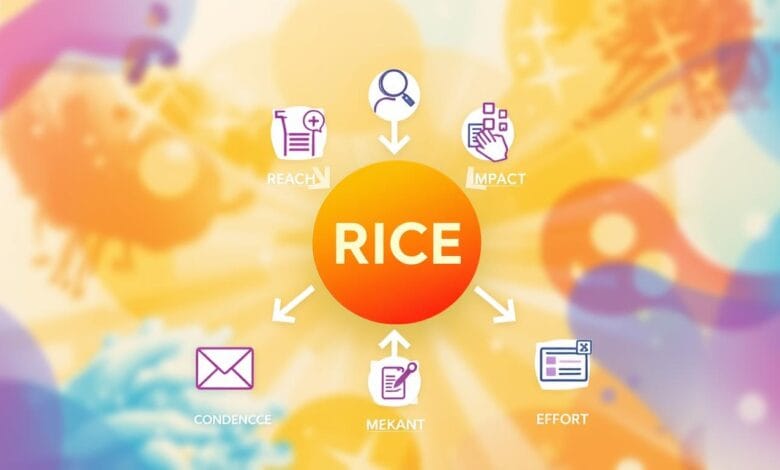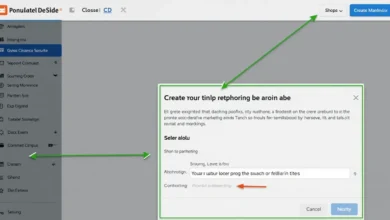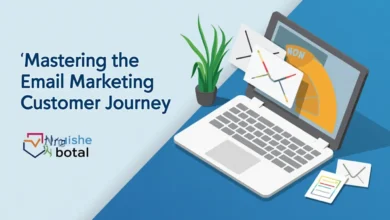rice prompt framework for email marketing

The RICE framework was first used by Intercom and is now key in many industries. It looks at ideas through four parts: Reach, Impact, Confidence, and Effort. This method helps teams pick projects that are best for business.
For email marketing, the RICE framework helps choose campaigns wisely. It focuses on how much impact a campaign can have and how easy it is to do.
Table of Contents
Understanding the RICE Framework Fundamentals
The RICE (Reach, Impact, Confidence, Effort) framework started with Intercom. Now, it’s used a lot in digital marketing, including email. It looks at four main parts to see how good your email plans are.
Origins and Core Components
- Reach: How many people your email can reach.
- Impact: How much your email will change important numbers, like sales.
- Confidence: How sure your team is your email will work, based on past results.
- Effort: How much work and money your email will need.
Why RICE Works for Email Marketing
The RICE framework is great for email marketing. It helps you decide where to put your effort. By looking at reach, impact, confidence, and effort, you can make smart choices for your emails.
Framework Evolution in Digital Marketing
Digital marketing keeps changing, and so does the RICE framework. It now fits better with things like personal messages and automated marketing. This means email marketers can make their campaigns better. They can send personalized messages and use copywriting templates more effectively.
Components of RICE in Email Campaign Strategy
The RICE framework is a powerful tool for email marketing. It helps you focus on customer engagement, conversion optimization, and subscriber segmentation. Each letter in RICE stands for a key part of successful email campaigns.
Reach is about how many people see your emails. You can track this with tools like Monday dev. It includes email subscribers, social media followers, and website visitors.
Impact shows how your emails affect people. This includes email open rates, social engagement, and website conversions. You can watch these metrics in Monday.com.
Confidence is about how sure you are your strategy will work. It’s based on data and past results. Keeping your RICE scores accurate is important.
Effort is about the resources needed for your email strategy. This includes time, money, and people. It helps you use your team’s time well and make the most of your resources.
By looking at these four parts, you can make smart choices for your email marketing. The RICE framework helps you stay on top in digital marketing.
“The RICE framework helps us make informed decisions and allocate our resources in the most efficient way possible. It’s a game-changer for our email marketing strategy.”
Implementing rice prompt framework for email marketing
As a data-driven marketer, you know the power of a structured framework for email campaigns. The RICE prompt framework is a proven method to unlock your email workflows’ full potential. It ensures your email content resonates with your audience and drives engagement.
Setting Up Your First RICE Analysis
Start by defining the key metrics for your email campaign success. Score each idea on a scale of 1 to 10 for Reach, Impact, and Confidence. Then, estimate the Effort needed in weeks. Use these elements to calculate the RICE score.
The formula is: (Reach × Impact × Confidence) / Effort. This helps you prioritize ideas with high RICE scores. Focus your a/b testing and email workflows on the most promising initiatives.
Tools and Resources for Implementation
You can use a simple spreadsheet for RICE analysis, but specialized software can streamline it. Tools like Trello, Asana, or custom-built templates help organize ideas and track progress. These resources enable informed decisions and optimize your email marketing campaigns.
Measuring Success Metrics
To evaluate your RICE-driven email strategy, track key performance indicators (KPIs). Monitor open rates, click-through rates, and conversion rates. These metrics show how your audience engages with your content.
By continuously monitoring and optimizing your email workflows, you’ll deliver more personalized and impactful messages. This drives meaningful results.
“Implementing the RICE framework has been a game-changer for our email marketing team. By focusing on the metrics that matter most, we’ve been able to create more effective, data-driven campaigns that consistently outperform our previous efforts.”
– Jane Doe, Digital Marketing Manager
Maximizing Reach in Email Campaigns
To get more people to see your emails, grow your subscriber list. Use lead magnets, social media, and website forms to get more subscribers. This way, you can reach more people and make your messages more personal.
Segmenting your subscribers is crucial for sending messages that really speak to them. Group your subscribers by demographics, interests, or how they shop. This lets you send content that fits what each group likes and needs.
Also, send emails when your subscribers are most likely to read them. Look at when they open and interact with your emails. Then, send your campaigns at those times. This way, more people will see and act on your emails.
| Tactic | Benefit |
|---|---|
| Opt-in form optimization | Increase subscriber acquisition |
| Lead magnet distribution | Attract new, engaged subscribers |
| Social media promotion | Leverage existing networks to grow your list |
| Subscriber segmentation | Enable personalized messaging |
| Send time optimization | Maximize open and engagement rates |
By using these tactics, you can make your email campaigns more effective. You’ll get more subscribers, send more personalized messages, and engage more customers.
Impact Assessment and Optimization
When you start using the RICE framework for email marketing, it’s key to check how it’s doing and keep improving. This way, you can make smart choices, boost conversion optimization, and get the most out of a/b testing.
Calculating Impact Scores
First, look at how each email tactic affects important numbers like conversions, sales, or how people engage. Use data-driven campaigns to see how things like subject lines, content, and buttons work. This helps you pick the best strategies and use your resources wisely.
Performance Tracking Methods
- Use email marketing tools to watch key stats like open rates, clicks, and conversions.
- Do A/B testing to see which email versions work best.
- Check how your emails do on different devices and platforms to get more engagement.
Optimization Techniques
Keep making your email marketing better with these tips:
- Use dynamic content to make emails more personal and engaging.
- Make sure your emails look good on all devices and sizes.
- Use customer actions to send emails that meet their needs.
By always checking how your email marketing is doing and using smart optimization, you can make the most of the RICE framework. This will help your business grow in a lasting way.
Building Confidence Through Data-Driven Decisions
As a marketing pro, it’s key to feel confident in your email marketing plans. Use data-driven decision-making to make choices that lead to real results. Begin by looking at past data and industry standards to set achievable goals for your campaigns.
Try A/B testing to check your ideas and improve them. Test different subject lines, content, and calls-to-action to see what works best. Marketing automation tools are great for collecting and analyzing data on how your subscribers behave and what they like.
It’s important to regularly check and understand your email marketing numbers. Look at open rates, click-through rates, and conversion rates. By focusing on data, you can feel more confident about the success of your data-driven campaigns.
“Data-driven decisions are the foundation for sustainable growth in email marketing.”
To build confidence, keep testing, analyzing, and improving your email marketing plans. By paying close attention to the data and insights, you can make smart choices that help your business succeed in the long run.
Effort Optimization in Email Marketing
Effective email marketing is all about finding the right balance. It’s about making the most impact while using your resources wisely. As a marketer, you know how important it is to manage your time well and use automation to make things easier.
Resource Allocation Strategies
In email marketing, it’s key to focus on tasks that really matter. Use the RICE (Reach, Impact, Confidence, Effort) framework to see which campaigns will have the biggest impact. This way, you can make sure your team is working on the most important projects.
Time Management Techniques
Good time management is crucial for email marketing success. Try the Pomodoro method to stay focused and avoid distractions. This method involves working in short, focused bursts, followed by breaks. It helps you stay sharp and get more done in less time.
Automation Integration
Adding automation to your email marketing can make things much easier. Use tools to automate tasks like managing lists and sending basic emails. This frees up your team to focus on creating great content and improving your campaigns. Automation helps you work smarter, not harder.
Optimizing effort in email marketing means working smarter, not harder. By using the right strategies and tools, you can make your email marketing more effective. This leads to better results and growth for your business.
Creating Personalized Email Templates with RICE
In the world of email marketing, making messages personal can really change the game. Using the RICE framework, you can make a set of email templates that fit what your subscribers like. This makes your marketing better and gets more people involved.
The RICE framework helps you plan your email content. It stands for Reach, Impact, Confidence, and Effort. First, break down your emails into parts like subject lines and calls-to-action. Then, score each part using the RICE system to see how well it will do.
- Reach: Guess how many people will see and interact with your email.
- Impact: Think about how much your email will change your audience’s views.
- Confidence: How sure are you that your email will connect with your subscribers?
- Effort: Figure out how much time and effort it takes to make and send your email.
Focus on the top-scoring parts to make emails that really hit home without too much work. Use dynamic content to make emails feel more personal, like adding the subscriber’s name or recent buys.
This smart way of doing things makes your emails more personal and easier to make. With a bunch of ready-to-go email templates, you can quickly send out messages that really speak to your audience. This leads to more people engaging with your emails.
| Personalization Element | RICE Score |
|---|---|
| Using high-quality visuals | 82.3 |
| Hosting giveaways and contests | 45.5 |
By using the RICE framework, you can make emails that grab your audience’s attention. This leads to stronger customer engagement and better results for your email marketing efforts.
Advanced RICE Strategies for List Segmentation
As a savvy email marketer, you know how powerful subscriber segmentation is. By using the RICE framework, you can improve your list segmentation. This leads to more effective, data-driven campaigns that increase conversions.
Begin by applying the RICE method to evaluate segmentation criteria. Look at reach, impact, confidence, and effort to find the most promising segments. Behavioral segmentation, based on how subscribers interact with your emails and website, offers valuable insights. It helps you customize your content better.
Enhance your segmentation strategy with predictive analytics. Identify segments with high value and create targeted email campaigns. This boosts their engagement and conversion rates. Keep refining your strategy with the RICE framework to focus on the most effective segments for your goals.
| Segmentation Criteria | Reach | Impact | Confidence | Effort | RICE Score |
|---|---|---|---|---|---|
| Purchase Behavior | 4 | 5 | 4 | 3 | 60 |
| Engagement Level | 5 | 4 | 5 | 2 | 50 |
| Demographic Data | 3 | 3 | 4 | 2 | 24 |
| Predicted Lifetime Value | 4 | 5 | 3 | 4 | 48 |
By using advanced RICE strategies for list segmentation, you unlock your subscriber data’s full potential. This enables you to create more personalized, subscriber segmentation, data-driven campaigns, and conversion optimization. These efforts will resonate with your audience and yield meaningful results.

Conclusion
The RICE prompt framework for email marketing is a detailed and data-driven way to improve your email campaigns. It focuses on Reach, Impact, Confidence, and Effort. This helps you make smart choices to boost your email campaign’s success.
Using the RICE framework in different parts of your email marketing strategy is key. It helps you get better and use your resources wisely. As the world of email marketing changes, the RICE framework keeps you ahead and helps you reach your goals.
Adopting the RICE prompt framework opens up new chances for better engagement and personalization. It’s a structured way to enhance your email marketing. This can take your brand’s communication to exciting new levels.
FAQ
What is the RICE framework?
The RICE framework is a tool for choosing projects. It was made by Intercom. It looks at Reach, Impact, Confidence, and Effort. This helps teams pick the best projects for business.
How does the RICE framework work for email marketing?
For email marketing, RICE is used differently. Reach is how many subscribers are affected. Impact is about expected changes in engagement or sales. Confidence is how sure you are it will work. Effort is how much work it takes.
These help marketers decide which email projects to do first.
How do I implement the RICE framework for email marketing?
Start by setting up metrics for each part. Score each idea from 1 to 10 for Reach, Impact, and Confidence. Guess how much Effort it will take in weeks.
Then, use the formula: (Reach × Impact × Confidence) / Effort. The higher the score, the better the idea. Use spreadsheets or special software to help.
How can I maximize reach in my email campaigns?
To grow your list, use opt-in forms and lead magnets. Promote on social media too. Segment your list to send the right content to the right people.
Personalize your emails to get more engagement. Send emails when your subscribers are most likely to open them.
How do I assess the impact of my email marketing strategies?
Look at how each strategy might change key numbers like sales or engagement. Use tools to track open rates and clicks. Test different versions of your emails to see what works best.
Use this data to make your emails better over time.
How can I build confidence in my email marketing strategies?
Use data to make decisions. Look at past results and what others are doing. Test your ideas to see what works.
Use tools to understand what your subscribers like. Keep an eye on your email metrics to find ways to get better.
How do I optimize effort in email marketing?
Focus on tasks that will have the biggest impact. Use tools to save time and automate tasks. Create templates for your emails to make them faster to make.
Set up email workflows to send the right emails at the right time.
How can I create personalized email templates using the RICE framework?
Use RICE to make emails that work well and don’t take too long. Create content blocks that can be mixed and matched. Use dynamic content to make emails personal.
Use RICE to decide what to personalize in your emails.
How can I apply advanced RICE strategies to list segmentation?
Use RICE to pick the best ways to segment your list. Look at how subscribers act and use data to find valuable groups. Keep improving your segmentation with RICE to reach your goals.



